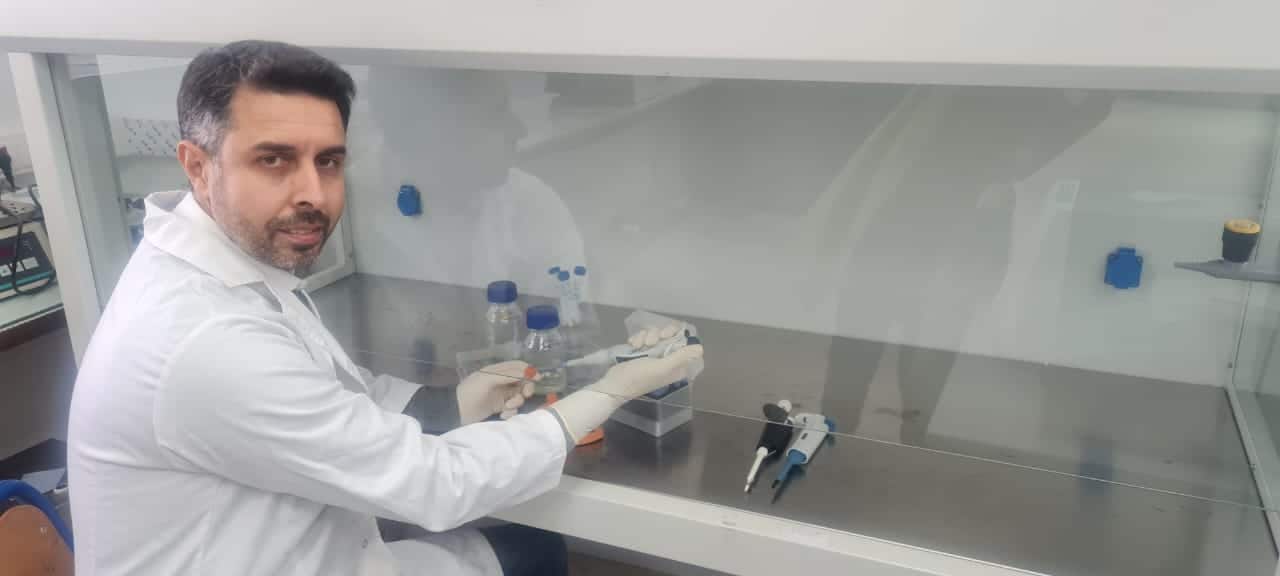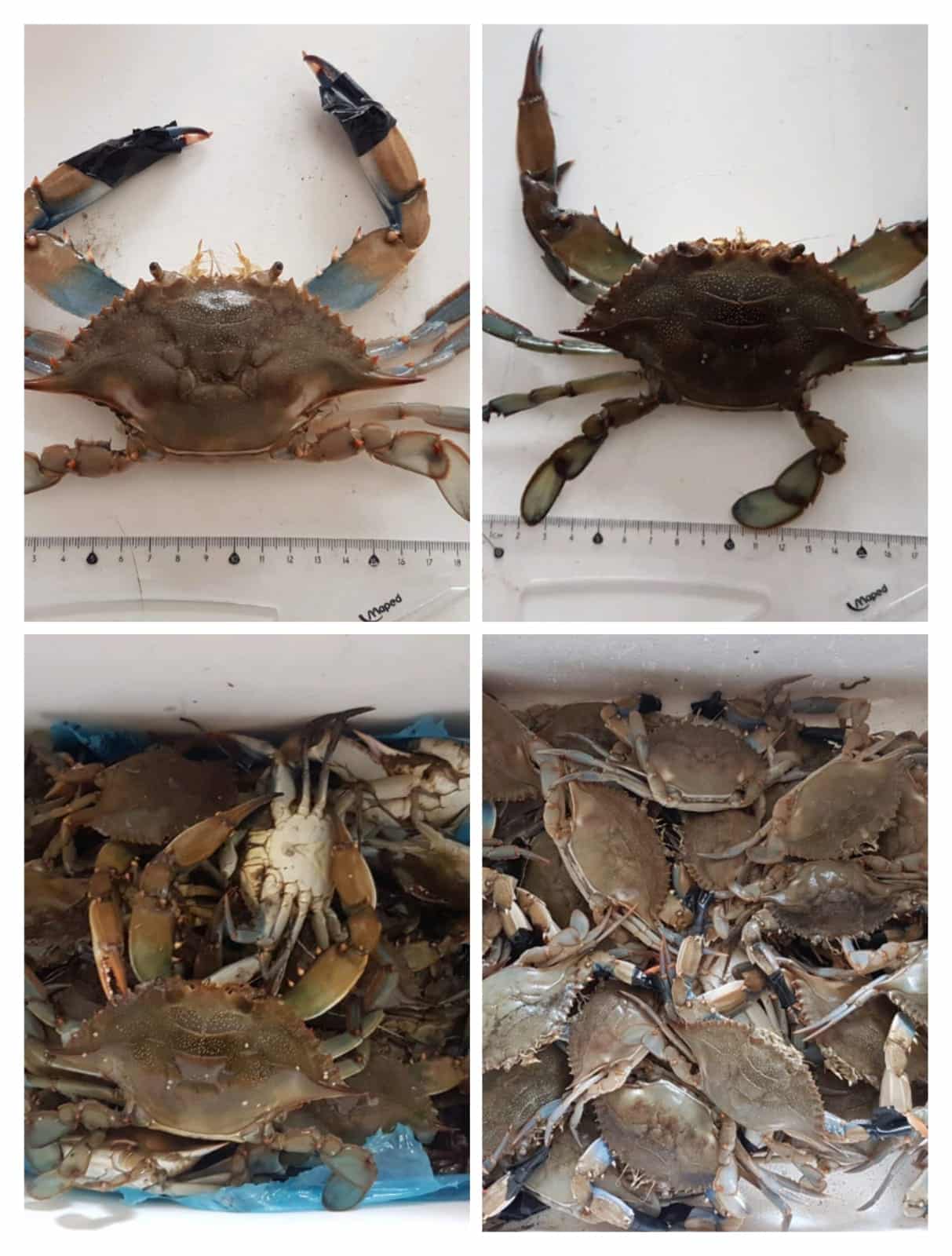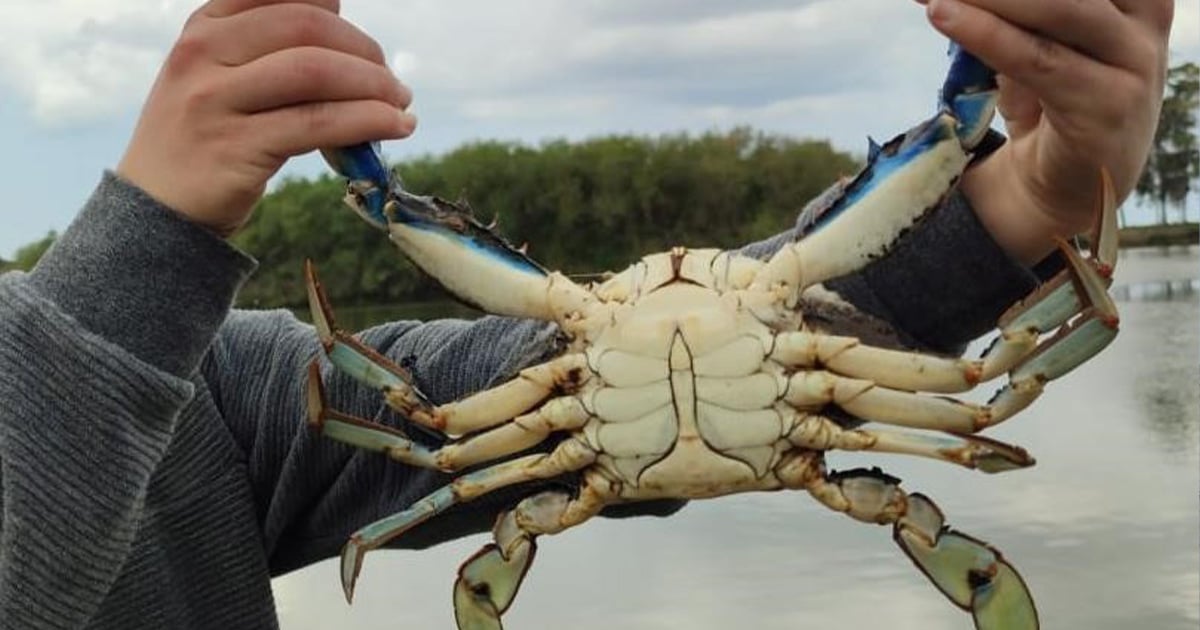It consumes living and dead organisms. It is the blue crab, or Callinectes sapidus.
The date of its first appearance in Moroccan coastal waters is unknown, but researchers at the regional center of the National Institute for Research in Marine Fisheries in the city of Nador, northern Morocco, confirmed that it was first observed in August 2017 in Marchika (Nador lagoon). Local fishermen said that it has been caught in their nets since 2018 and that it was also found on the coasts of the city of Tangier in 2020. Since then, it has been fished daily, with daily catches reaching around 30 kilograms in the city of Larache. Each crab can weigh up to 1000 grams in the Mulay Bousselham lagoon. It is sold in the fish markets of Larache, Tangier, Rabat, and Casablanca.
A study revealed that the first gathering of blue crabs was recorded in February 2021 on the western coasts of Morocco. It was also found at the mouth of the Kert River and the Moulouya River, west and east of the Nador lagoon, respectively. Afterward, it spread widely in the Larache region of the Loukous Valley on the Atlantic coast, where it found favorable conditions for its rapid reproduction.
Dr. Hisham Chairi, of the Abdelmalek Essaadi University in Tétouan, said that a total of 110 of them were taken as study samples, with only two males. All the ones collected in the coastal waters of the Loukous River, northern Morocco (a river that originates in the vicinity of the Chefchaouen region and flows into the Atlantic Ocean north of the city of Larache), in the months of June and July, were females. Most blue crabs taken in November were males. The width of the shell of females varies between 80 and 150 millimeters, while males have shells that measure between 82 and 160 millimeters. Specimens have also been recorded near the Mediterranean port of Tangier, in the rivers “Tahadart” and “Greifa”, Moulay Bousselham lagoon, and El Jadida.
 Dr. Hicham Chairi in his laboratory. (Image credit: Mohammed Tafraouti)
Dr. Hicham Chairi in his laboratory. (Image credit: Mohammed Tafraouti)
The post-larval stage settles on the Mediterranean bank in low-salinity nurseries in late summer and autumn. Its young overwinter in nursery areas and quickly grows to sexual maturity before mating.
Invasive alien species constitute one of the main threats to almost all species at risk of extinction, changing the functioning of key ecosystems and the biological richness of the Mediterranean Sea. This new species negatively affect the ecosystem of indigenous communities. It also threatens its existence and ecological balance.
After the jellyfish infested some Moroccan coasts, the blue crab arrived with the help of commercial ships crossing the sea, with its larvae being transported by the water that vessels suck up to stabilize their load (also known as ballast water) and emptied out when they reach their destination. Or, as other versions say, it is possible that the larvae spread by sea currents or were intentionally introduced for commercial purposes.
The blue crab has physiological peculiarities that make it dominant. It is very strong, has powerful claws, and uses its hind legs as oars. It is a decapod crustacean, having five pairs of blue legs, and it has sharp front and side teeth. It also has a dark green color, and its body is covered with a solid, polygonal, round-shaped exoskeleton with a soft belly.
It usually breeds in shallow waters of coasts, lakes, and upper estuaries, that is, in waters with low salinity. After mating, the females migrate seaward to a higher salinity, where they release larval incubators. The larvae re-enter, and settlement occurs in the lower bays or estuaries, after which the juveniles migrate to the upper reaches in low-salinity habitats.
Dr. Hicham Chairi has confirmed that the blue crab is not an isolated organism but often lives in communities of 100 or more individuals. It causes many problems, as it feeds on various types of fish in the area, gets stuck in fishermen’s nets, and is difficult to remove. It causes losses to fishing gear and tear nets.
Professional fishermen working in the Marchika lagoon and the rest of the regions are increasingly concerned about the repercussions that these crabs have on the quality of their catch, especially as it devours small fish and other species and causes the deterioration of nets.
Blue crabs cause a loss of biodiversity and must be dealt with through the application of a preventive or therapeutic principle that repels the factors contributing to the invasion of the Mediterranean basin.
From here, scientific research intervenes, and a study is being conducted targeting 110 male and female blue crabs. They were collected from the coastal waters of Morocco using bait traps between February and December 2021. The seizure comes in support of previous research on hundreds of blue crabs, mostly females, collected from various locations along the Moroccan coast.
 Different type of blue crabs being measured, Tunisia, 2023. (Image credit: Mohammed Tafraouti)
Different type of blue crabs being measured, Tunisia, 2023. (Image credit: Mohammed Tafraouti)
Chairi reported that he was informed of the first appearance of this species of crustaceans in the Tangier and Tangier Mediterranean ports of the Strait of Gibraltar.
The study concluded that this expansion and spread is natural, following the previous arrival of blue crab groups to the “Mediterranean port”, which is the largest port in Africa. However, a genetic study of these populations is needed to further clarify the questions surrounding its continued spread along the northwest coast of Africa.
Local fishermen stated that there is a demand for the acquisition of this type of crustacean, and the price reaches between 35 to 50 dirhams per kilogram. Crab is sold at fish auctions in Larache, Tangier, and Rabat.
To find out whether this widespread is the result of a single entry that led to biological reproduction or several migrations, Chairi said that a genetic and chronological overview of its recent expansion in the West and east of the Strait of Gibraltar was conducted. A joint study was completed with Moroccan and Spanish researchers that traced the process of significant blue crab spread along the Gulf of Cadiz and the Moroccan coasts in the north-east Atlantic Ocean to know the possibility of genetic differences that can be detected within the Mediterranean blue crab. The study assessed the genetic makeup of crabs from the Gulf of Cadiz and the Alboran Sea.
Chairi reported that the testing process included the gene sequence of the Cytochrome oxidase subunit I (COI), with a full length of approximately 1511 base pairs of 149 individuals from three sites along the Spanish Mediterranean coast, two in the Alboran Sea, and two in the Gulf of Cadiz. The study data revealed low genetic variation, with only two haplotypes, compared to the high genetic diversity known in its native range, indicating a strong influence in the study area.
“Here we document an inversion of haplotype predominance between regions, haplotype CSWM2 being dominant in most of the Spanish Mediterranean coast, but less frequent in the Gulf of Cadiz and the Alboran Sea, which includes the coasts of Spain in the north, Morocco and Algeria in the south and connects the Mediterranean Sea with the Atlantic Ocean,” he explained.
Only two haplotypes were identified in the seven Atlantic blue crab populations analyzed in this study, herein referred to as CSWM1 and CSWM2. Reference samples for the crustacean decapod group were deposited at the Spanish Institute of Oceanography in Cadiz, Spain (IEO-CSIC).
The Spanish Mediterranean coast witnessed a predominance of the CSWM2 haplotype with a range of 53 to 80%, while the Gulf of Cadiz and the Alboran Sea were dominated by the CSWM1 haplotype with a range of 67 to 78%.
This suggests a secondary introduction of propagules into the investigated area rather than a new introduction from the native area, nor a natural westward expansion. Additional studies will help to better reveal the history of other invasive species in the Gulf of Cadiz. The study concluded that populations of Atlantic blue crabs were found in the east and west of the Strait of Gibraltar. It currently consists of two individual patterns in the Gulf of Cadiz and the Alboran Sea.
It is necessary to provide incentives to fishermen to increase the catch of this species of crustaceans, especially during the breeding season. A fisherman, Hassan, explains how to catch these crabs through cages placed in the depths of the water. The crabs are sold to restaurants in Casablanca and in public markets in some Mediterranean cities, where it is in abundance in the summer period (June, and July).
Mohamed Rais, an expert in cooking fish and a former employee of the most famous fish restaurants in Casablanca, said that the method of cooking blue crab applies to the rest of the crustaceans, eaten by Moroccans in several ways. Its meat, located behind his hard shell, is chunky and appetizing. They are also delicious by steaming them, boiling them in water, or grilling them. “I therefore call for providing this type of crustaceans, rich in beneficial nutrients, to the Moroccan consumer, with a Large Offer in public markets, instead of being limited to restaurants and major hotels,” he said.
These invasive species are being monitored by researchers to study their settlement dynamics in the region. The basic data to date have allowed many conclusions to be drawn, including their prevalence, size structure and socioeconomic impact. Studies indicate the abundance of this species continue to increase at the level of Moroccan Mediterranean lagoon and coasts.
*This story was produced with support from Internews’ Earth Journalism Network.

